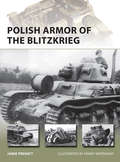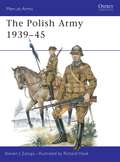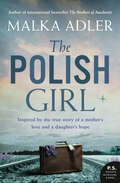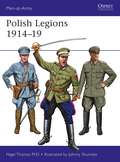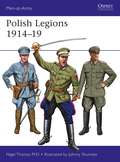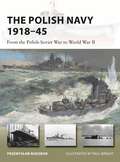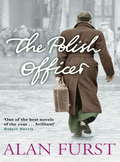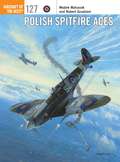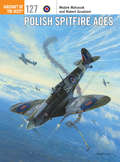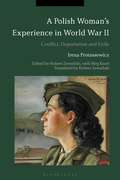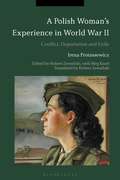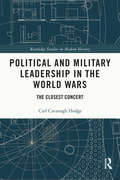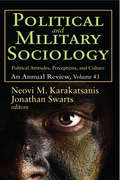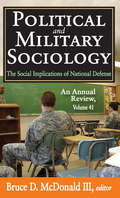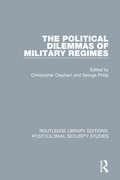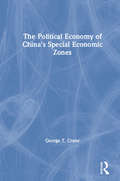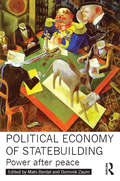- Table View
- List View
Polish Armor of the Blitzkrieg (New Vanguard #224)
by Jamie Prenatt Mr Henry MorsheadThe Polish army during the Blitzkrieg conjures up tragic images of infantry and dashing, but ineffective and ultimately doomed cavalry charges. In actuality the Poles, in the midst of a large-scale re-armament programme, had up to 600 armoured vehicles available at the time of the German attack, as well as a number of newer and better designs in various stages of development. Facing the inventors of the 'Lightning War', who attacked in great numbers, on multiple fronts and with total mastery of the air, the Polish armoured formations were up against it. But outdated equipment, doctrine and enormous odds did not stop these units from fighting with bravery and determination before being finally overwhelmed. This volume is a complete technical study of the machines that formed the backbone of Poland's defences on the ground, using never-before-seen photographs and a comprehensive design and developmental history that reveal a full picture of Poland's armoured forces in the context of their greatest challenge.
The Polish Army 1939–45 (Men-at-Arms #117)
by Steven J. Zaloga Richard HookPoland was the first of the Allied nations to succumb to German aggression in the Second World War, but by the most tortuous of routes her army managed to remain in the field through all five years of bloody fighting. Polish soldiers fought in nearly every major campaign in the European theatre, and their tale is a complicated and tragic one. This richly detailed text by Steven Zaloga relates the story of the Polish Army during the Second World War, from the first wave of Stukas in 1939 to its eventual conclusion.
The Polish Army 1939–45 (Men-at-Arms #117)
by Steven J. Zaloga Richard HookPoland was the first of the Allied nations to succumb to German aggression in the Second World War, but by the most tortuous of routes her army managed to remain in the field through all five years of bloody fighting. Polish soldiers fought in nearly every major campaign in the European theatre, and their tale is a complicated and tragic one. This richly detailed text by Steven Zaloga relates the story of the Polish Army during the Second World War, from the first wave of Stukas in 1939 to its eventual conclusion.
The Polish Girl
by Malka AdlerIn the eye of the war That tore the world apart A mother wants a son A daughter needs a mother
Polish Legions 1914–19 (Men-at-Arms #518)
by Johnny Shumate Nigel ThomasDue to its partitions and dissolution in the late eighteenth century, hundreds of thousands of Polish soldiers enlisted in distinct units in the armies of many countries – primarily those of the Russian and Austro-Hungarian empires, but also that of the German Reich and the French Republic.All these forces were uniformed and equipped by the parent armies, though often with explicitly Polish features. The collapse of Tsarist Russia in 1917 and of the Central Powers in 1918 allowed these diverse forces to unite in a re-created Polish Army under the new-born Second Polish Republic in November 1918. With full colour illustrations of their unique and colourful uniforms as well as contemporary photographs, this is the fascinating story of the Poles who fought on both sides of the trenches in World War I and then united to fight for their freedom in the Russian Civil War.
Polish Legions 1914–19 (Men-at-Arms #518)
by Johnny Shumate Nigel ThomasDue to its partitions and dissolution in the late eighteenth century, hundreds of thousands of Polish soldiers enlisted in distinct units in the armies of many countries – primarily those of the Russian and Austro-Hungarian empires, but also that of the German Reich and the French Republic.All these forces were uniformed and equipped by the parent armies, though often with explicitly Polish features. The collapse of Tsarist Russia in 1917 and of the Central Powers in 1918 allowed these diverse forces to unite in a re-created Polish Army under the new-born Second Polish Republic in November 1918. With full colour illustrations of their unique and colourful uniforms as well as contemporary photographs, this is the fascinating story of the Poles who fought on both sides of the trenches in World War I and then united to fight for their freedom in the Russian Civil War.
The Polish Navy 1918–45: From the Polish-Soviet War to World War II (New Vanguard)
by Przemyslaw BudzbonPacked with illustrations, this is a study of the Polish warships such as the Grom-class destroyers that were developed and built in the interwar years.Newly independent Poland's naval force was created in 1920, initially with six ex-German torpedo boats. However, after German-Soviet exercises off the Polish coast in 1924, funding for warships was hastily allocated. Two destroyers and three submarines were built in France but, disappointed with their quality, Poland ordered new ships, mostly from British and Dutch shipyards. By summer 1939, the Polish Navy comprised four destroyers, five submarines, one minelayer, six minesweepers and a handful of lesser ships. Although the Grom-class destroyers were two of the fastest and best-armed destroyers of the war, the tiny Polish fleet would stand little chance against the Kriegsmarine, and on 30 August three destroyers were dispatched to Britain, followed by two submarines that escaped internment. The remaining Polish surface fleet was sunk by 3 September. In exile, the Polish Navy operated not only their own ships, but also Royal Navy warships, including a cruiser, destroyers, submarines and motor torpedo boats which fought alongside the Allies in the Battle of the Atlantic, the Arctic Convoys, and at the Normandy landings. This detailed account not only describes the Polish Navy's contribution to the Allied war effort but also the episode of the Polish destroyer Piorun which took on the Bismarck in a lone gun duel leading to the sinking of the great German battleship.
The Polish Navy 1918–45: From the Polish-Soviet War to World War II (New Vanguard)
by Przemyslaw BudzbonPacked with illustrations, this is a study of the Polish warships such as the Grom-class destroyers that were developed and built in the interwar years.Newly independent Poland's naval force was created in 1920, initially with six ex-German torpedo boats. However, after German-Soviet exercises off the Polish coast in 1924, funding for warships was hastily allocated. Two destroyers and three submarines were built in France but, disappointed with their quality, Poland ordered new ships, mostly from British and Dutch shipyards. By summer 1939, the Polish Navy comprised four destroyers, five submarines, one minelayer, six minesweepers and a handful of lesser ships. Although the Grom-class destroyers were two of the fastest and best-armed destroyers of the war, the tiny Polish fleet would stand little chance against the Kriegsmarine, and on 30 August three destroyers were dispatched to Britain, followed by two submarines that escaped internment. The remaining Polish surface fleet was sunk by 3 September. In exile, the Polish Navy operated not only their own ships, but also Royal Navy warships, including a cruiser, destroyers, submarines and motor torpedo boats which fought alongside the Allies in the Battle of the Atlantic, the Arctic Convoys, and at the Normandy landings. This detailed account not only describes the Polish Navy's contribution to the Allied war effort but also the episode of the Polish destroyer Piorun which took on the Bismarck in a lone gun duel leading to the sinking of the great German battleship.
The Polish Officer
by Alan FurstFrom the master of the historical spy thriller, a story set in the heart of the Polish resistanceSeptember, 1939. The invading Germans blaze a trail of destruction across Poland. France and Britain declare war, but do nothing to help. And a Polish resistance movement takes shape under the shadow of occupation, enlisting those willing to risk death in the struggle for their nation's survival. Among them is Captain Alexander de Milja, an officer in the Polish military intelligence service, a cartographer who now must learn a dangerous new role: spymaster in the anti-Nazi underground. Beginning with a daring operation to smuggle the Polish National Gold Reserve to the government in exile, he slips into the shadowy and treacherous front lines of espionage; he moves through Europe, changing identities and staying one step ahead of capture. In Warsaw, he engineers a subversive campaign to strengthen the people's will to resist. In Paris, he poses as a Russian poet, then as a Slovakian coal merchant, drinking champagne in black-market bistros with Nazis while uncovering information about German battle plans. And a love affair with a woman of the French Resistance leads him to make the greatest decision of his life.
Polish Spitfire Aces (Aircraft of the Aces)
by Wojtek Matusiak Robert GrudzienOf all Allied airmen, Polish pilots had had the most experience of fighting the Luftwaffe by the time the war came to Britain. As the Battle of Britain raged, they quickly proved themselves as highly aggressive and skilful interceptors, especially when flying the famous Spitfire. The Polish Air Force eventually became the largest non-Commonwealth Spitfire operator, using some 1,500 Mks I, II, V, IX and XVI to devastating effect. Top scoring USAAF ace of the ETO, Francis "Gabby" Gabreski and a whole host of other Allied and Commonwealth aces flew with Polish squadrons, adding even more to their fighting quality. Conversely, several Polish pilots were attached to other Allied squadrons throughout the war, demonstrating their prowess alongside airmen from a whole host of nations. From an expert on Polish fighter aviation, this is a peerless account of the fiery, talented Polish "Spit" pilots, whose country had been overrun and whose aggression and determination to shoot down Axis aircraft was unmatched.
Polish Spitfire Aces (Aircraft of the Aces #124)
by Wojtek Matusiak Robert GrudzienOf all Allied airmen, Polish pilots had had the most experience of fighting the Luftwaffe by the time the war came to Britain. As the Battle of Britain raged, they quickly proved themselves as highly aggressive and skilful interceptors, especially when flying the famous Spitfire. The Polish Air Force eventually became the largest non-Commonwealth Spitfire operator, using some 1,500 Mks I, II, V, IX and XVI to devastating effect. Top scoring USAAF ace of the ETO, Francis "Gabby" Gabreski and a whole host of other Allied and Commonwealth aces flew with Polish squadrons, adding even more to their fighting quality. Conversely, several Polish pilots were attached to other Allied squadrons throughout the war, demonstrating their prowess alongside airmen from a whole host of nations. From an expert on Polish fighter aviation, this is a peerless account of the fiery, talented Polish "Spit" pilots, whose country had been overrun and whose aggression and determination to shoot down Axis aircraft was unmatched.
A Polish Woman’s Experience in World War II: Conflict, Deportation and Exile
by Meg Knott Hubert Zawadzki Irena ProtassewiczThis hitherto unpublished first-hand witness account, written in 1968-9, tells the story of a privileged Polish woman whose life was torn apart by the outbreak of the Second World War and Soviet occupation. The account has been translated into English from the original Polish and interwoven with letters and depositions, and is supplemented with commentary and notes for invaluable historical context. Irena Protassewicz's vivid account begins with the Russian Revolution, followed by a rare insight into the life and mores of the landed gentry of northeastern Poland between the wars, a rural idyll which was to be shattered forever by the coming of the Second World War. Deported in a cattle truck to Siberia and sentenced to a future of forced labour, Irena's fortunes were to change dramatically after Hitler's attack on Russia. She charts the adventure and horror of life as a military nurse with the Polish Army, on a journey that would take her from the wastes of Soviet Central Asia, through the Middle East, to an unlikely ending in the highlands of Scotland. The story concludes with Irena's search to discover the wartime and post-war fate of her family and friends on both sides of the Iron Curtain, and the challenges of life as a refugee in Britain. A Polish Woman's Experience in World War II provides a compelling, personal route into understanding how the greatest conflict of the 20th century transformed the lives of the individuals who lived through it.
A Polish Woman’s Experience in World War II: Conflict, Deportation and Exile
by Irena Protassewicz Hubert Zawadzki Meg KnottThis hitherto unpublished first-hand witness account, written in 1968-9, tells the story of a privileged Polish woman whose life was torn apart by the outbreak of the Second World War and Soviet occupation. The account has been translated into English from the original Polish and interwoven with letters and depositions, and is supplemented with commentary and notes for invaluable historical context. Irena Protassewicz's vivid account begins with the Russian Revolution, followed by a rare insight into the life and mores of the landed gentry of northeastern Poland between the wars, a rural idyll which was to be shattered forever by the coming of the Second World War. Deported in a cattle truck to Siberia and sentenced to a future of forced labour, Irena's fortunes were to change dramatically after Hitler's attack on Russia. She charts the adventure and horror of life as a military nurse with the Polish Army, on a journey that would take her from the wastes of Soviet Central Asia, through the Middle East, to an unlikely ending in the highlands of Scotland. The story concludes with Irena's search to discover the wartime and post-war fate of her family and friends on both sides of the Iron Curtain, and the challenges of life as a refugee in Britain. A Polish Woman's Experience in World War II provides a compelling, personal route into understanding how the greatest conflict of the 20th century transformed the lives of the individuals who lived through it.
Political and Military Leadership in the World Wars: The Closest Concert (Routledge Studies in Modern History #78)
by Carl Cavanagh HodgeThis book approaches the World Wars and the decades between them as a single unit in modern history. It is impossible to understand either the cause or conduct of the 1939–45 war without an appreciation of the issues not wholly answered in the conflict of 1914–18. Bridging the World Wars was the establishment, revision, and ultimate collapse of the Versailles settlement and the League of Nations system between 1919 and 1939. The 1919 settlement was contested in the 1920s by Fascist Italy and began to unravel irreparably in 1931 with Japan’s incursion into Manchuria. The strategic thought of the interwar years is therefore especially instructive in assessing the prosecution of WWII, as the military ventures of these two revisionist powers pointed toward future developments even before Germany thrust a new way of war upon Eastern and Western Europe. Meanwhile, Britain, France, and the United States began an incremental conversion to new approaches to war in the air and on the sea in particular. The interwar decades are best understood as a period of calibrated rearmament by all the powers based on assumptions about the probability of a future war and the nature of its prosecution.
Political and Military Leadership in the World Wars: The Closest Concert (Routledge Studies in Modern History #78)
by Carl Cavanagh HodgeThis book approaches the World Wars and the decades between them as a single unit in modern history. It is impossible to understand either the cause or conduct of the 1939–45 war without an appreciation of the issues not wholly answered in the conflict of 1914–18. Bridging the World Wars was the establishment, revision, and ultimate collapse of the Versailles settlement and the League of Nations system between 1919 and 1939. The 1919 settlement was contested in the 1920s by Fascist Italy and began to unravel irreparably in 1931 with Japan’s incursion into Manchuria. The strategic thought of the interwar years is therefore especially instructive in assessing the prosecution of WWII, as the military ventures of these two revisionist powers pointed toward future developments even before Germany thrust a new way of war upon Eastern and Western Europe. Meanwhile, Britain, France, and the United States began an incremental conversion to new approaches to war in the air and on the sea in particular. The interwar decades are best understood as a period of calibrated rearmament by all the powers based on assumptions about the probability of a future war and the nature of its prosecution.
Political and Military Sociology: Volume 43, Political Attitudes, Perceptions, and Culture: An Annual Review (Political And Military Sociology Ser.)
by Neovi M. KarakatsanisThis volume encompasses a wide range of empirical research on a variety of topics that are related by their focus on the importance of attitudes, culture, and perceptions. The significance of public attitudes, the impact of cultural norms, and the perceptions of military officers and civilians are all analysed in the seven articles in this latest edition of Political and Military Sociology.The first essay asserts that military memoirs should be taken seriously as objects of scholarly analysis. Using the Minorities at Risk Dataset, the second article examines the effects of globalization on ethnic conflict in 106 countries from 1985 to 2002. The next focuses on Canadian attitudes toward military expenditures following the September 11th terrorist attacks. The fourth examines the attitudes of Texans toward recent US wars, the draft, and military service generally.The fifth essay explores the role of the media in promoting democracy and democratic attitudes in southern Africa. Using survey data, the following article addresses the extent to which higher education promotes more tolerant attitudes among Israeli Jews toward Israeli Arabs. The volume concludes with a study of US warrant officers that shows how the rank has evolved over time.
Political and Military Sociology: Volume 43, Political Attitudes, Perceptions, and Culture: An Annual Review
by Neovi M. KarakatsanisThis volume encompasses a wide range of empirical research on a variety of topics that are related by their focus on the importance of attitudes, culture, and perceptions. The significance of public attitudes, the impact of cultural norms, and the perceptions of military officers and civilians are all analysed in the seven articles in this latest edition of Political and Military Sociology.The first essay asserts that military memoirs should be taken seriously as objects of scholarly analysis. Using the Minorities at Risk Dataset, the second article examines the effects of globalization on ethnic conflict in 106 countries from 1985 to 2002. The next focuses on Canadian attitudes toward military expenditures following the September 11th terrorist attacks. The fourth examines the attitudes of Texans toward recent US wars, the draft, and military service generally.The fifth essay explores the role of the media in promoting democracy and democratic attitudes in southern Africa. Using survey data, the following article addresses the extent to which higher education promotes more tolerant attitudes among Israeli Jews toward Israeli Arabs. The volume concludes with a study of US warrant officers that shows how the rank has evolved over time.
Political and Military Sociology: Volume 41, The Social Implications of National Defense: An Annual Review
by I. I. I. McDonaldPolitical and Military Sociology, Volume 41 explores the social elements and impact of national defense. The origin of government is a response to a society's common interest in security and defense. In recent years, security and defense issues, and government responses, have become increasingly prominent in societies around the world. Despite intermittent pushes for privatization, however, security and defense have remained core functions of government.In this volume Bruce D. McDonald III investigates the historiography of the defense-growth relationship. Lachezar G. Anguelov and Robert J. Eger III consider the social impact with a case study of the Republic of Serbia. Maximiliano Mendieta and Bruce D. McDonald III consider the social spillovers of the sector that arise after the completion of a soldier's service. Paul Kellogg considers why some countries have fared well when others have been slow to rebound. Hamid E. Ali studies pork barrel spending in the United States. Susan Sample, Brandon Valeriano, and Choong-Nam Kang broaden the understanding of the defense sector to include its output. Hamid E. Ali and Ubah A. Adan conclude the volume with a study on conflict and infant and child mortality rates.Traditionally, national defense is viewed solely in military terms. As part of their national security objectives, many defense sectors have undertaken a variety of social programs. While the existence of social programs is known, what remains uncertain is how they spill over from the sector to society at-large and what is the impact of that spillover.
Political and Military Sociology: Volume 41, The Social Implications of National Defense: An Annual Review (Political And Military Sociology Ser.)
by Bruce D. McDonald IIIPolitical and Military Sociology, Volume 41 explores the social elements and impact of national defense. The origin of government is a response to a society's common interest in security and defense. In recent years, security and defense issues, and government responses, have become increasingly prominent in societies around the world. Despite intermittent pushes for privatization, however, security and defense have remained core functions of government.In this volume Bruce D. McDonald III investigates the historiography of the defense-growth relationship. Lachezar G. Anguelov and Robert J. Eger III consider the social impact with a case study of the Republic of Serbia. Maximiliano Mendieta and Bruce D. McDonald III consider the social spillovers of the sector that arise after the completion of a soldier's service. Paul Kellogg considers why some countries have fared well when others have been slow to rebound. Hamid E. Ali studies pork barrel spending in the United States. Susan Sample, Brandon Valeriano, and Choong-Nam Kang broaden the understanding of the defense sector to include its output. Hamid E. Ali and Ubah A. Adan conclude the volume with a study on conflict and infant and child mortality rates.Traditionally, national defense is viewed solely in military terms. As part of their national security objectives, many defense sectors have undertaken a variety of social programs. While the existence of social programs is known, what remains uncertain is how they spill over from the sector to society at-large and what is the impact of that spillover.
The Political Dilemmas of Military Regimes
by Christopher Clapham and George PhilipFirst published in 1985, The Political Dilemmas of Military Regimes was written against the backdrop of the increased prominence of military intervention in the political process during this century. The book puts forward the argument that the basic problem for military regimes is not how they gain power, but what they can do with it once they have it. It discusses the enormous range of cultural and historical circumstances that military organisations are derived from, and how widely they vary in their structure, politics, and social composition. The book also highlights the dilemma of choosing between institutionalisation and demilitarisation as one that all military regimes must eventually face. The Political Dilemmas of Military Regimes is an in-depth study that draws on global material and experiences from throughout the century.
The Political Dilemmas of Military Regimes
by Christopher Clapham George PhilipFirst published in 1985, The Political Dilemmas of Military Regimes was written against the backdrop of the increased prominence of military intervention in the political process during this century. The book puts forward the argument that the basic problem for military regimes is not how they gain power, but what they can do with it once they have it. It discusses the enormous range of cultural and historical circumstances that military organisations are derived from, and how widely they vary in their structure, politics, and social composition. The book also highlights the dilemma of choosing between institutionalisation and demilitarisation as one that all military regimes must eventually face. The Political Dilemmas of Military Regimes is an in-depth study that draws on global material and experiences from throughout the century.
The Political Economy of China's Economic Zones
by George T. CraneIn 1979 China launched a new international economic policy with the establishment of four Special Economic Zones (SEZs): Shenzhen, Zhuhai, and Shantou in Guangdong Province and Xiamen in Fujian Province. Modelled loosely on export processing zones and free trade zones found in other less developed countries, the SEZs offer a variety of financial inducements to foreign investors in order to harness international business for national economic advantage. Designed to be a cornerstone of China's economic reforms, by 1985 the SEZs (in the mid-80s zone-like policies were extended to fourteen coastal cities) were scandal-ridden and fraught with serious problems. This work, the first book-length analysis in English of China's SEZs, examines the problems and promise of this innovative approach to "structural economic reform" and the comparative significance of the SEZs.
The Political Economy of China's Economic Zones
by George T. CraneIn 1979 China launched a new international economic policy with the establishment of four Special Economic Zones (SEZs): Shenzhen, Zhuhai, and Shantou in Guangdong Province and Xiamen in Fujian Province. Modelled loosely on export processing zones and free trade zones found in other less developed countries, the SEZs offer a variety of financial inducements to foreign investors in order to harness international business for national economic advantage. Designed to be a cornerstone of China's economic reforms, by 1985 the SEZs (in the mid-80s zone-like policies were extended to fourteen coastal cities) were scandal-ridden and fraught with serious problems. This work, the first book-length analysis in English of China's SEZs, examines the problems and promise of this innovative approach to "structural economic reform" and the comparative significance of the SEZs.
Political Economy of Statebuilding: Power after peace
by Mats BerdalThis volume examines and evaluates the impact of international statebuilding interventions on the political economy of post-conflict countries over the past 20 years. While statebuilding today is typically discussed in the context ofpeacebuilding and ‘stabilisation operations, the current phase of interest in external interventions to (re)build and strengthen governmental institutions can be traced back to thegood governance policies of the International Financial Institutions (IFIs) in the early 1990s. These sought political changes and improvements in the quality of governance in countries that were subject to, or were seeking support under, IFI-designed structural adjustment programmes.The focus of this book is specifically on state-building efforts in conflict-affected countries: countries that are emerging, or have recently emerged, from periods of war and violent conflict. The interventions covered in the present volume fall into three broad and overlapping categories:International administrations and transformative occupations (East Timor, Iraq, and Kosovo); Complex peace operations (Afghanistan, Burundi, Haiti, and Sudan); Governance and state-building programmes conducted in the context of economic assistance (Georgia and Macedonia).This book will be of much interest to students of statebuilding, humanitarian intervention, post-conflict reconstruction, political economy, international organisations and IR/Security Studies in general.
Political Economy of Statebuilding: Power after peace
by Mats Berdal and Dominik ZaumThis volume examines and evaluates the impact of international statebuilding interventions on the political economy of post-conflict countries over the past 20 years. While statebuilding today is typically discussed in the context ofpeacebuilding and ‘stabilisation operations, the current phase of interest in external interventions to (re)build and strengthen governmental institutions can be traced back to thegood governance policies of the International Financial Institutions (IFIs) in the early 1990s. These sought political changes and improvements in the quality of governance in countries that were subject to, or were seeking support under, IFI-designed structural adjustment programmes.The focus of this book is specifically on state-building efforts in conflict-affected countries: countries that are emerging, or have recently emerged, from periods of war and violent conflict. The interventions covered in the present volume fall into three broad and overlapping categories:International administrations and transformative occupations (East Timor, Iraq, and Kosovo); Complex peace operations (Afghanistan, Burundi, Haiti, and Sudan); Governance and state-building programmes conducted in the context of economic assistance (Georgia and Macedonia).This book will be of much interest to students of statebuilding, humanitarian intervention, post-conflict reconstruction, political economy, international organisations and IR/Security Studies in general.
